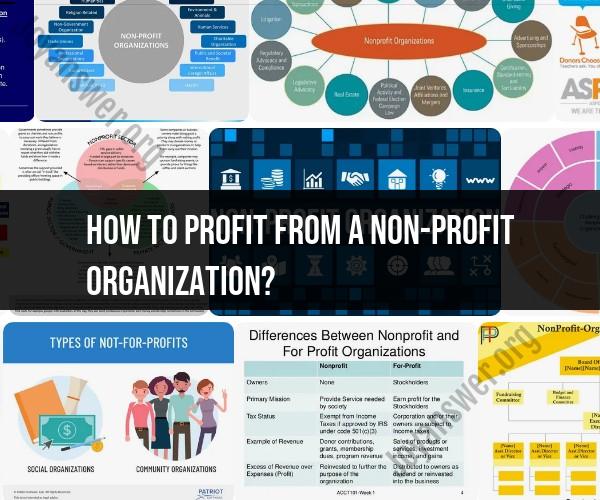How to profit from a non-profit organization?
Nonprofit organizations, by definition, are not created for the purpose of generating profit for individuals or shareholders. Instead, they are established to pursue a mission, serve a community, or advance a cause. However, nonprofits do require financial sustainability to achieve their goals. Here's how a nonprofit can achieve financial sustainability without generating profits for individuals:
Diversify Funding Sources:
Grants: Apply for grants from government agencies, foundations, and private organizations that align with your mission.
Donations: Encourage individual and corporate donations. Launch fundraising campaigns and explore recurring donation programs.
Membership Fees: If applicable, charge membership fees for access to specific services or benefits within the organization.
Earned Income: Generate income through services or products that align with your mission. For example, a nonprofit animal shelter can offer pet adoption services or training classes.
Events: Host fundraising events, workshops, seminars, or conferences to raise funds and engage with supporters.
Financial Management:
- Maintain strong financial management practices, including budgeting, financial reporting, and transparent accounting. Effective financial management ensures you make the most of available resources.
Endowment Funds:
- Create an endowment fund to invest and generate income to support your nonprofit's ongoing activities.
Collaborations and Partnerships:
- Partner with other nonprofit organizations, businesses, or government agencies to share resources and reduce costs. Collaboration can also lead to joint fundraising efforts.
Impact Investing:
- Explore opportunities for impact investing, where investors provide capital to support your mission while expecting a financial return that can be reinvested in the organization.
Social Enterprise:
- Launch social enterprise ventures that align with your mission. Income generated from these ventures can support your nonprofit's activities.
Fee-for-Service:
- Charge fees for specific services or programs that your nonprofit offers. These fees can be a source of revenue without conflicting with nonprofit status.
Leverage Volunteers:
- Engage volunteers to reduce labor costs. Many nonprofits rely on volunteers to carry out their missions effectively.
Grant Management:
- Maximize grant management by ensuring that you meet the requirements of grant funding. This includes reporting on how the funds were used to further the mission.
Board Development:
- Engage your board members in fundraising efforts and provide training in fundraising and financial stewardship.
Earned Income Tax Considerations:
- Be aware of the tax implications of earned income. Some activities might be subject to unrelated business income tax (UBIT). Consult with a tax expert to ensure compliance.
Regular Assessment:
- Continuously assess the financial health of your organization, including your cash flow, fundraising efforts, and expenses. Make necessary adjustments to remain financially sustainable.
Reserve Fund:
- Build a reserve fund for emergencies or unexpected expenses. Having a financial cushion can prevent financial crises.
Remember, the goal of a nonprofit organization is to reinvest any surplus funds back into its mission and the community it serves. Generating a surplus is different from generating a profit for personal gain. Financial sustainability allows nonprofits to fulfill their mission, serve their constituents, and create a positive impact on society while responsibly managing their resources.
Profiting from a Nonprofit Organization: A Guide to Sustainability
Nonprofit organizations can generate revenue in a variety of ways, including:
- Grants: Grants are a common source of funding for nonprofits. Grants can come from foundations, government agencies, and individuals.
- Donations: Donations are another important source of revenue for nonprofits. Donations can come from individuals, corporations, and foundations.
- Fees for services: Some nonprofits charge fees for their services. For example, a nonprofit that provides job training may charge a fee for its classes.
- Product sales: Some nonprofits sell products to generate revenue. For example, a nonprofit that supports environmental causes may sell reusable water bottles.
- Social enterprises: Social enterprises are businesses that are owned and operated by nonprofits. Social enterprises sell products or services and use the profits to support the nonprofit's mission.
Balancing Financial Stability and Mission in Nonprofits
It is important for nonprofits to balance financial stability with their mission. Nonprofits need to generate enough revenue to cover their costs and support their programs. However, they also need to stay true to their mission and avoid making decisions that compromise their values.
There are a number of ways that nonprofits can balance financial stability and mission. Here are a few examples:
- Diversify your funding sources. Don't rely on any one source of funding, such as grants or donations. This will help to reduce your risk if one source of funding dries up.
- Create a business plan. A business plan will help you to think about your revenue streams, expenses, and goals. It will also help you to track your progress and make adjustments as needed.
- Be transparent with your donors and supporters. Let them know how you are using their money and how it is helping to achieve your mission.
- Be innovative. There are many new and innovative ways to generate revenue for nonprofits. Be open to new ideas and experiment with different approaches.
Innovative Approaches to Generate Income for Nonprofits
Here are a few innovative approaches to generate income for nonprofits:
- Social enterprises: Social enterprises are businesses that are owned and operated by nonprofits. Social enterprises sell products or services and use the profits to support the nonprofit's mission.
- Crowdfunding: Crowdfunding platforms allow nonprofits to raise money from a large number of small donors.
- Corporate sponsorships: Nonprofits can partner with corporations for sponsorships. Corporations can provide financial support, products, or services in exchange for exposure and branding opportunities.
- Cause marketing: Cause marketing is a type of marketing that partners a for-profit company with a nonprofit organization. The company donates a portion of its proceeds to the nonprofit or provides other forms of support.
- Matching gifts: Many companies offer matching gift programs to their employees. When an employee makes a donation to a nonprofit, the company will match the donation, up to a certain amount.
Strategies for Building Long-Term Viability in Nonprofit Ventures
To build long-term viability in nonprofit ventures, it is important to focus on the following:
- Have a clear mission and vision. What is your nonprofit trying to achieve? What impact do you want to make? Having a clear mission and vision will help you to stay focused and make decisions that are aligned with your values.
- Develop a strong business plan. Your business plan should outline your revenue streams, expenses, and goals. It should also include a plan for how you will measure your success.
- Build a strong team. Surround yourself with talented and passionate people who are committed to your mission.
- Be innovative. The nonprofit landscape is constantly changing, so it is important to be innovative and adaptable. Be open to new ideas and experiment with different approaches.
- Be transparent and accountable. Let your donors and supporters know how you are using their money and how it is helping to achieve your mission. Be accountable for your results and make adjustments as needed.
Success Stories and Lessons Learned in Nonprofit Profitability
There are many successful nonprofit organizations that have generated significant revenue. Here are a few examples:
- Habitat for Humanity: Habitat for Humanity is a nonprofit that builds homes for low-income families. Habitat for Humanity generates revenue through donations, government grants, and the sale of homes.
- Goodwill Industries: Goodwill Industries is a nonprofit that provides job training and employment services to people with disabilities and other barriers to employment. Goodwill generates revenue through the sale of donated goods and the provision of job training and employment services.
- Salvation Army: The Salvation Army is a nonprofit that provides a variety of social services, including food assistance, shelter, and disaster relief. The Salvation Army generates revenue through donations, government grants, and the sale of goods and services.
These are just a few examples of successful nonprofit organizations that have generated significant revenue. There are many other nonprofits that are doing innovative and important













